December 3, 2024 · 11 min read
Improving Documentation and Follow-Ups for Legal Advisory Committees

Shaimaa Badawi
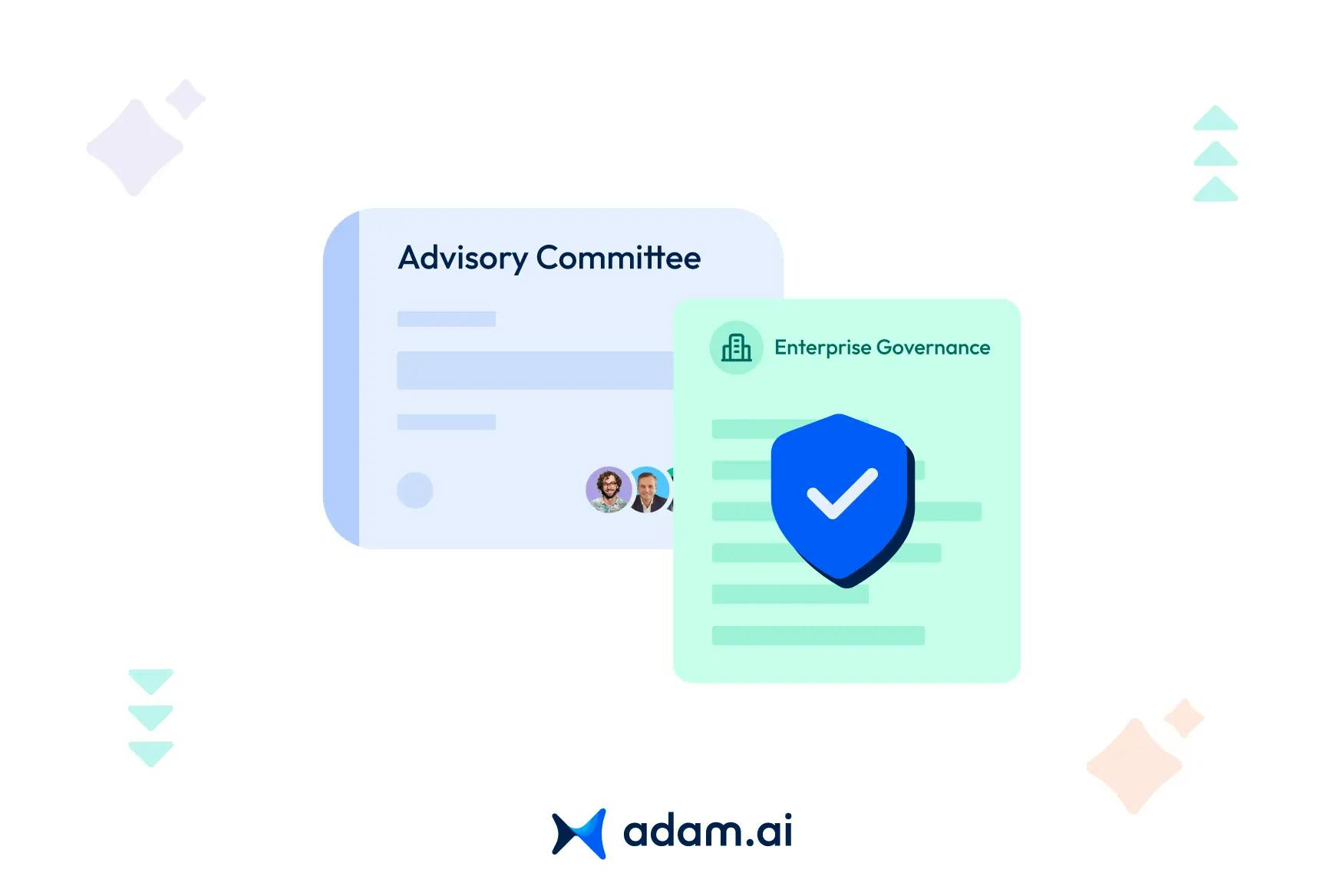
Legal advisory committees are the backbone of enterprise governance, ensuring compliance, mitigating risks, and providing expert guidance. Yet, without robust documentation and effective follow-ups, even the most strategic committees can struggle to maintain accountability and achieve meaningful outcomes. In this article, we explore the importance of effective documentation, the challenges faced by legal advisory committees, and the best practices and tools that can transform their processes and drive significant impact for their organizations.
What is the role of legal advisory committees in enterprise governance?
Legal advisory committees play a pivotal role in enterprise governance by providing specialized guidance and oversight that strengthens decision-making and ensures compliance with legal and regulatory requirements. Their contributions enhance an organization’s ability to navigate complex legal landscapes while maintaining accountability and transparency.
How legal advisory committees contribute to governance:
- Strategic guidance: Committees offer expert advice on legal, regulatory, and strategic matters, ensuring that decisions align with the organization’s long-term objectives and mitigate potential risks.
- Policy development: By reviewing and recommending policies, legal advisory committees help enterprises establish frameworks that promote ethical governance and compliance with industry standards.
- Risk mitigation: These committees proactively identify legal risks and propose measures to address them, safeguarding the organization against financial penalties, reputational harm, or operational disruptions.
- Accountability and oversight: Through regular reviews of decisions and processes, legal advisory committees ensure transparency and hold stakeholders accountable, reinforcing trust within and outside the organization.
- Conflict resolution: Legal advisory committees often mediate disputes and provide clarity on contentious issues, helping the enterprise maintain stability and focus on its strategic goals.
Why is effective documentation essential for legal advisory committees?
Effective documentation is vital for legal advisory committees because it establishes a foundation for accountability, clarity, and operational efficiency. In the context of complex legal and regulatory matters, documentation ensures that every discussion, decision, and recommendation is meticulously recorded, creating a reliable reference for future actions.
Why effective documentation is essential:
- Accountability: Comprehensive records provide transparency into the committee’s activities, making it clear who is responsible for specific decisions and follow-ups. This accountability fosters trust among stakeholders and strengthens the committee's credibility.
- Continuity and consistency: Detailed documentation ensures continuity, especially when committee membership changes. New members can quickly access historical records to understand past discussions and decisions, enabling a seamless transition.
- Compliance and risk mitigation: Legal advisory committees often handle sensitive matters requiring strict adherence to laws and regulations. Accurate documentation serves as evidence of due diligence and helps mitigate compliance risks by showcasing adherence to best practices.
- Informed decision-making: Documentation acts as a knowledge repository, offering valuable insights from past discussions. This empowers the committee to make informed, strategic decisions based on prior analyses and outcomes.
- Operational efficiency: Organized records reduce time spent revisiting previous discussions, allowing the committee to focus on forward-looking strategies and urgent matters.
What are the challenges in managing documentation for legal advisory committees?
Managing documentation for legal advisory committees comes with several challenges that can hinder efficiency and accountability if not addressed effectively. Identifying these pain points and implementing targeted solutions ensures smoother operations and better outcomes.
Challenges in managing documentation:
- Fragmented records: Documentation scattered across multiple locations or formats makes it difficult to access relevant information quickly.
- Inconsistent standards: Without standardized templates or formats, documentation may vary in quality and completeness, leading to gaps in critical records.
- Time-intensive processes: Manual documentation processes, such as minute-taking and follow-up tracking, consume valuable time and increase the risk of human error.
- Security concerns: Sensitive legal information requires secure storage to prevent unauthorized access and ensure compliance with regulations.
- Lack of accountability: Inadequate follow-up on documented decisions can result in unresolved actions and diminished trust in the committee's efficacy.
- Difficulty in version control: Managing updates and revisions to documents can create confusion, especially when multiple stakeholders are involved.
Solutions to address these challenges:
- Centralized digital platforms: Implement a centralized document management system or meeting platform to store, organize, and retrieve all records efficiently.
- Standardized templates: Use pre-designed templates for meeting agendas, minutes, and reports to ensure consistency and clarity in documentation.
- Automation tools: Leverage AI-powered tools for real-time minute-taking, action tracking, and progress monitoring to reduce manual workloads and errors.
- Enhanced security measures: Adopt platforms with robust security features, such as encryption and role-based access controls, to safeguard sensitive information.
- Accountability features: Incorporate task assignment and tracking systems to ensure timely follow-ups on decisions and action items.
- Version control systems: Utilize technology that tracks changes and maintains a history of document versions, ensuring transparency and accuracy.
What are the best practices for documenting decisions in legal advisory committees?
Documenting decisions in legal advisory committees requires a structured and systematic approach to ensure clarity, accessibility, and accountability. Following best practices not only enhances the effectiveness of the committee but also builds a comprehensive record for future reference and compliance purposes.
Best practices for documenting decisions:
- Establish a standardized format: Use a consistent template for documenting decisions, which includes essential elements like the date, attendees, agenda items, and action points. This ensures uniformity and makes records easier to review.
- Clearly state decisions and rationales: Document decisions with precise language, outlining the context, rationale, and expected outcomes. This provides clarity and avoids ambiguity in interpreting the committee’s conclusions.
- Assign responsibilities and deadlines: Clearly specify who is responsible for implementing each decision and set deadlines to ensure accountability and timely execution.
- Incorporate supporting documents: Attach relevant reports, presentations, or data that were considered during the decision-making process. These documents provide additional context and substantiate the committee’s decisions.
- Record dissenting opinions: Include any dissenting views or minority opinions expressed during discussions. This fosters transparency and highlights the diversity of thought within the committee.
- Approve and distribute meeting minutes promptly: Ensure minutes are reviewed and approved by committee members shortly after the meeting. Distribute them promptly to relevant stakeholders for awareness and follow-up.
- Use centralized digital platforms: Leverage meeting management solutions to store and organize records securely. These platforms make it easy to retrieve past decisions and track their implementation status.
- Maintain a comprehensive decision log: Create a decision log summarizing all past decisions, actions, and outcomes. This serves as a quick reference guide for the committee and stakeholders.
How can poor follow-up practices hinder the effectiveness of legal advisory committees?
Poor follow-up practices can severely impact the effectiveness of legal advisory committees, creating operational and strategic challenges that limit their contributions to governance. Here’s how:
- Erosion of accountability: Without effective follow-ups, tracking action items and responsibilities becomes difficult. This leads to unresolved tasks, reducing trust in the committee’s recommendations and its ability to deliver tangible results.
- Loss of continuity: Legal advisory committees often work on multi-layered issues that evolve over time. Poor follow-up practices can disrupt continuity by losing critical insights or documents, forcing members to revisit past discussions and delaying progress.
- Increased compliance risks: When follow-up actions related to legal or regulatory advice are overlooked, the organization may fail to address compliance gaps or adapt to changing regulations. This exposes the enterprise to penalties or reputational damage.
- Missed strategic opportunities: Inefficient follow-ups can result in missed opportunities to implement strategic decisions, impacting the organization’s ability to stay competitive or proactive in the legal landscape.
How can legal advisory committees ensure accountability and transparency through effective follow-ups?
Legal advisory committees can ensure accountability and transparency through effective follow-ups by implementing structured processes, leveraging technology, and fostering clear communication. Follow-ups are critical for transforming decisions into actions and maintaining trust among stakeholders.
Strategies to ensure accountability and transparency:
- Assign clear responsibilities: After each meeting, assign tasks with specific owners, deadlines, and deliverables. This makes it easy to track who is responsible for each action item and ensures accountability.
- Monitor progress: Use tracking tools to monitor the status of assigned tasks. Regular updates on the progress of action items keep everyone informed and aligned with objectives.
- Document and communicate decisions: Maintain detailed records of decisions made, including their context and intended outcomes. Share these records with all relevant stakeholders to ensure clarity and transparency.
- Set regular check-ins: Schedule follow-up meetings or progress reviews to discuss the status of action items. These sessions ensure that tasks are being executed and provide opportunities to address roadblocks.
- Centralize follow-up processes: Use a centralized platform to document, track, and manage all follow-ups. This ensures that no action item is overlooked and provides a clear audit trail for accountability.
- Measure outcomes: Evaluate the impact of completed actions against the committee’s objectives. Sharing these results reinforces the importance of follow-ups and demonstrates the committee’s effectiveness.
- Promote transparency through reporting: Regularly generate and distribute reports summarizing progress, challenges, and outcomes. This helps stakeholders stay informed and builds trust in the committee’s processes.
How does technology streamline documentation and follow-up for legal advisory committees?
Technology plays a transformative role in streamlining documentation and follow-up processes for legal advisory committees by offering tools that enhance efficiency, accuracy, and accessibility. Leveraging modern meeting management platforms ensures that committees can focus on their strategic objectives while minimizing administrative burdens.
Key ways technology streamlines documentation:
- Automated minute-taking: Meeting platforms often feature AI-powered tools that automatically generate accurate minutes, capturing key points, decisions, and action items in real-time. This reduces manual effort and ensures consistency.
- Centralized record storage: Digital solutions provide a secure and centralized repository for storing all committee documents, including minutes, reports, and supporting materials. This ensures easy retrieval and eliminates the risk of misplaced records.
- Searchable archives: Advanced indexing and search capabilities enable committees to quickly locate specific documents or past decisions, saving time and improving operational efficiency.
- Template-based standardization: Pre-designed templates ensure that documentation follows a consistent format, improving clarity and reducing errors.
Enhancing follow-up processes with technology:
- Action item tracking: Meeting management tools enable committees to assign, monitor, and update action items in real-time. Automated reminders help ensure that responsibilities are fulfilled on time.
- Real-time collaboration: Cloud-based platforms allow members to collaborate on decisions, updates, and follow-ups asynchronously, reducing delays and maintaining momentum.
- Progress monitoring: Dashboards provide a visual overview of ongoing tasks, completed actions, and pending follow-ups, helping committees stay organized and accountable.
- Audit trails: Technology creates a clear record of who made changes, when, and why, fostering transparency and ensuring compliance with governance standards.
Why is centralization crucial for the success of legal advisory committees in enterprises?
Centralization is crucial for the success of legal advisory committees in enterprises because it enhances efficiency, ensures accessibility, and fosters accountability. By consolidating information, workflows, and communications in one place, committees can focus on delivering strategic value without being hindered by operational inefficiencies.
Why centralization is crucial:
- Improved accessibility: Centralized systems allow committee members to access relevant documents, decisions, and updates from a single platform, eliminating time spent searching through fragmented records.
- Streamlined decision-making: By having all information organized and readily available, committees can make informed decisions more quickly, reducing delays caused by incomplete or inaccessible data.
- Enhanced collaboration: Centralization fosters seamless collaboration among members by providing a shared space for discussions, document reviews, and action tracking, even in remote or hybrid environments.
- Accountability and transparency: With centralized documentation, it’s easier to track decisions, responsibilities, and follow-ups, ensuring that all actions are executed and recorded. This builds trust and transparency within the organization.
- Reduced redundancy and errors: A unified system prevents duplication of effort and ensures consistency across all committee activities, minimizing errors and discrepancies.
- Scalability for complex enterprises: As organizations grow, centralization supports the scalability of legal advisory committees by enabling them to handle larger volumes of information and more complex workflows efficiently.
How to achieve centralization:
- Adopt digital platforms: Utilize meeting management platforms like adam.ai that centralize meeting schedules, agendas, documentation, and follow-ups in a single interface.
- Integrate tools and processes: Link centralized systems with other enterprise tools, such as project management or compliance software, for a holistic view of operations.
- Standardize documentation: Use templates and consistent formats to ensure all records align with the committee’s and enterprise’s standards.
How can adam.ai enhance documentation and follow-ups in legal advisory committees?
adam.ai enhances documentation and follow-ups in legal advisory committees by offering a suite of tailored features that address the unique needs of these committees. Here's how:
1. Agenda management
adam.ai simplifies agenda creation, allowing legal advisory committees to set clear objectives for every meeting. With features like assigning agenda items to specific members and allocating time for discussions, the platform ensures that meetings stay focused and productive. Agendas can be saved as templates, making it easier to replicate structured workflows for recurring sessions.
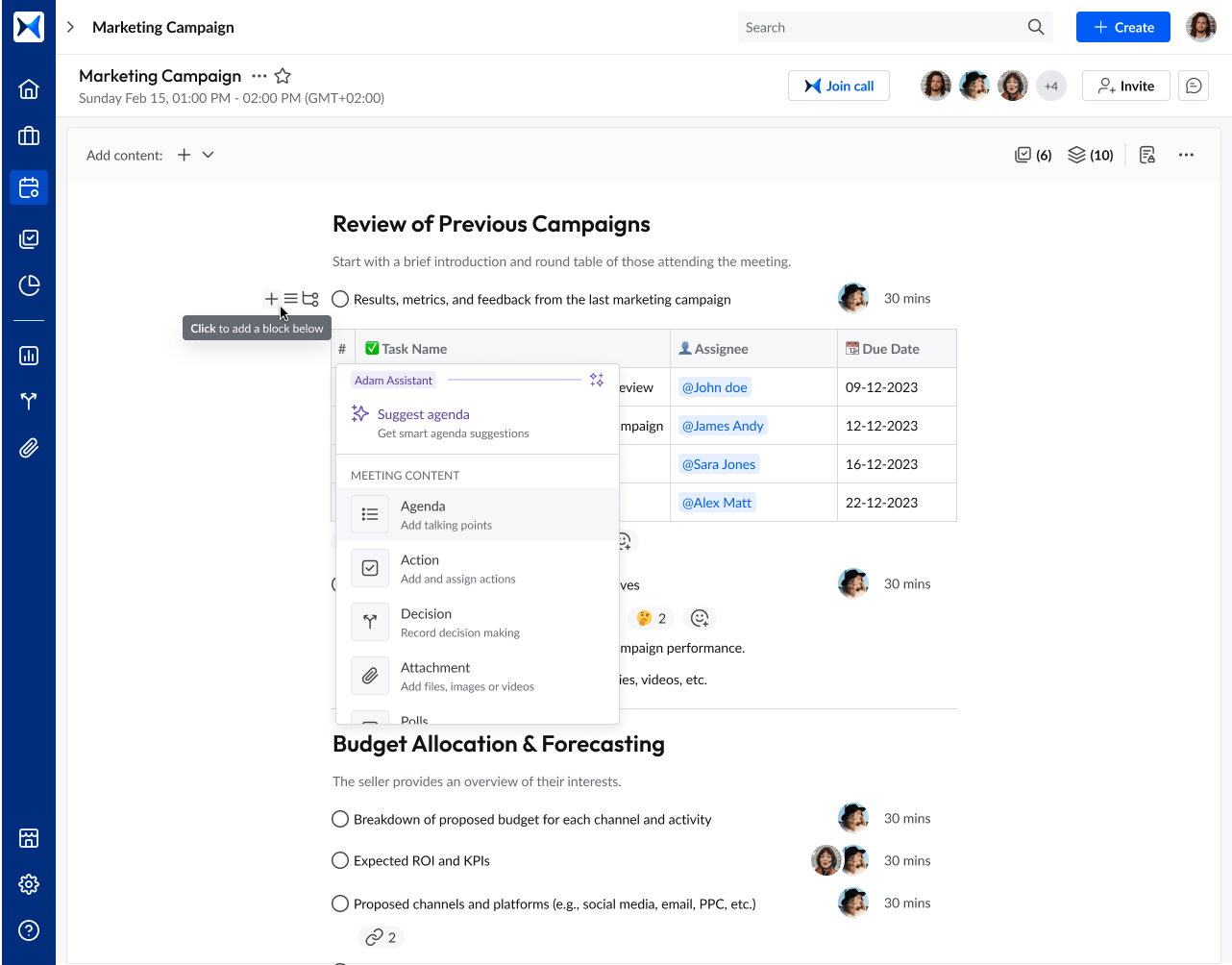
2. Content collaboration
Legal advisory committees often deal with complex documents and legal content. adam.ai enables seamless collaboration by providing a centralized platform for sharing, reviewing, and annotating files. Committee members can discuss documents in real-time, ensuring that everyone is aligned and informed before decisions are made.
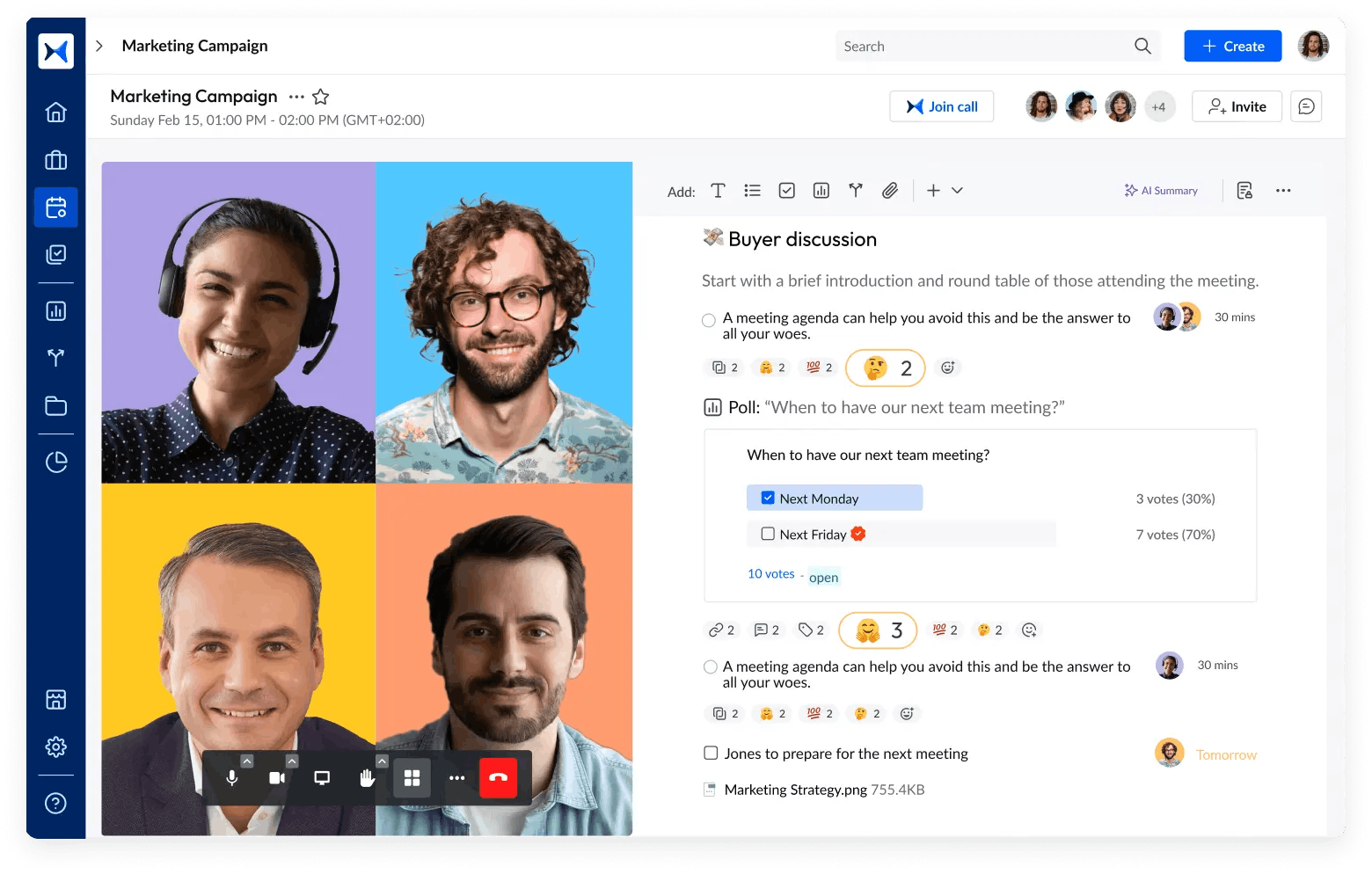
3. Action tracking
Follow-ups are critical for translating decisions into measurable outcomes. adam.ai’s action tracking feature ensures that every decision made during a meeting is assigned to the right person, with clear deadlines and deliverables. Automated reminders and progress tracking keep tasks on schedule, enhancing accountability and transparency.
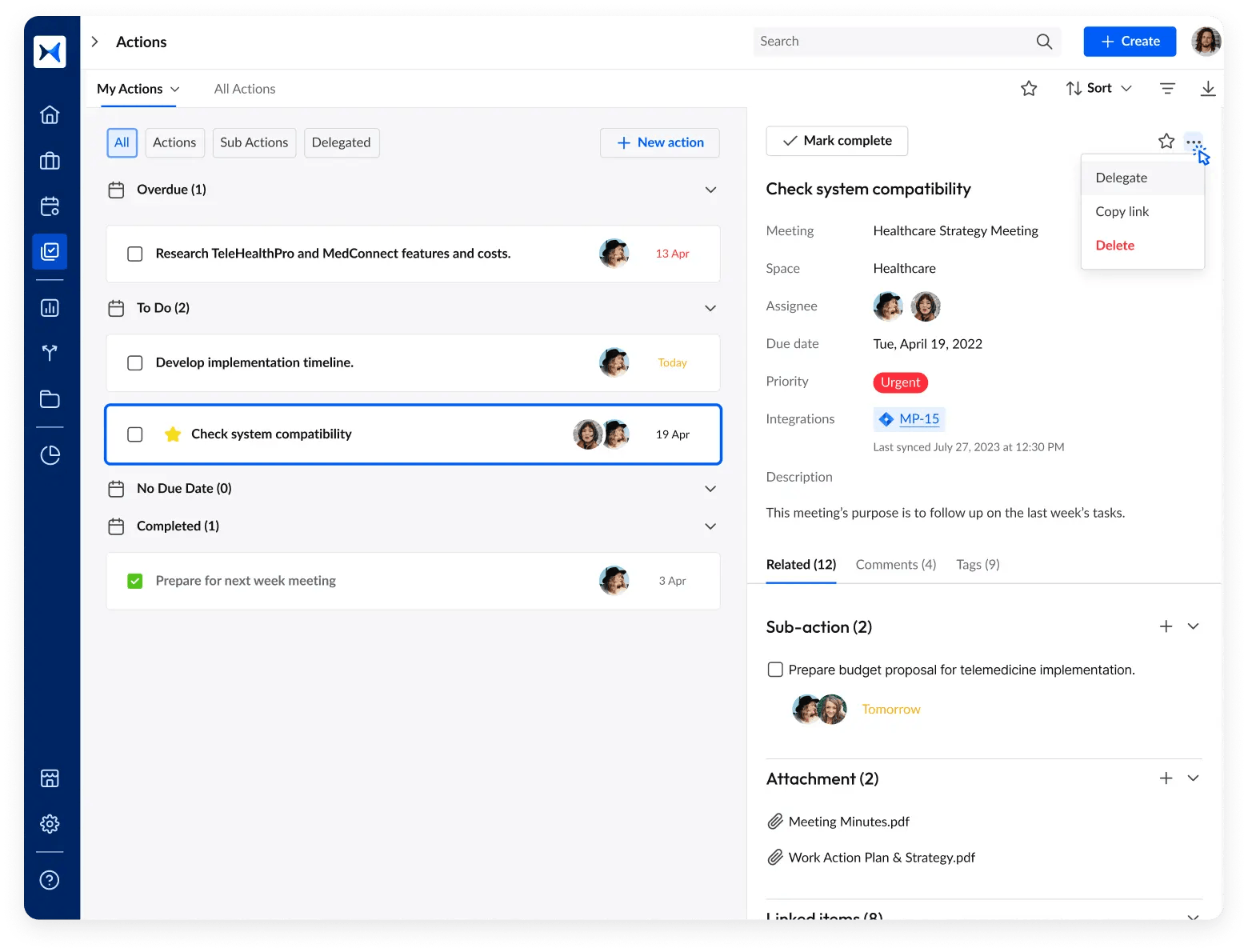
4. Meeting minutes
adam.ai automates the creation of detailed, accurate meeting minutes. By capturing key discussions, decisions, and assigned actions, the platform ensures a reliable record that can be easily reviewed and shared. This feature reduces the administrative burden and ensures that all committee documentation is comprehensive and standardized.
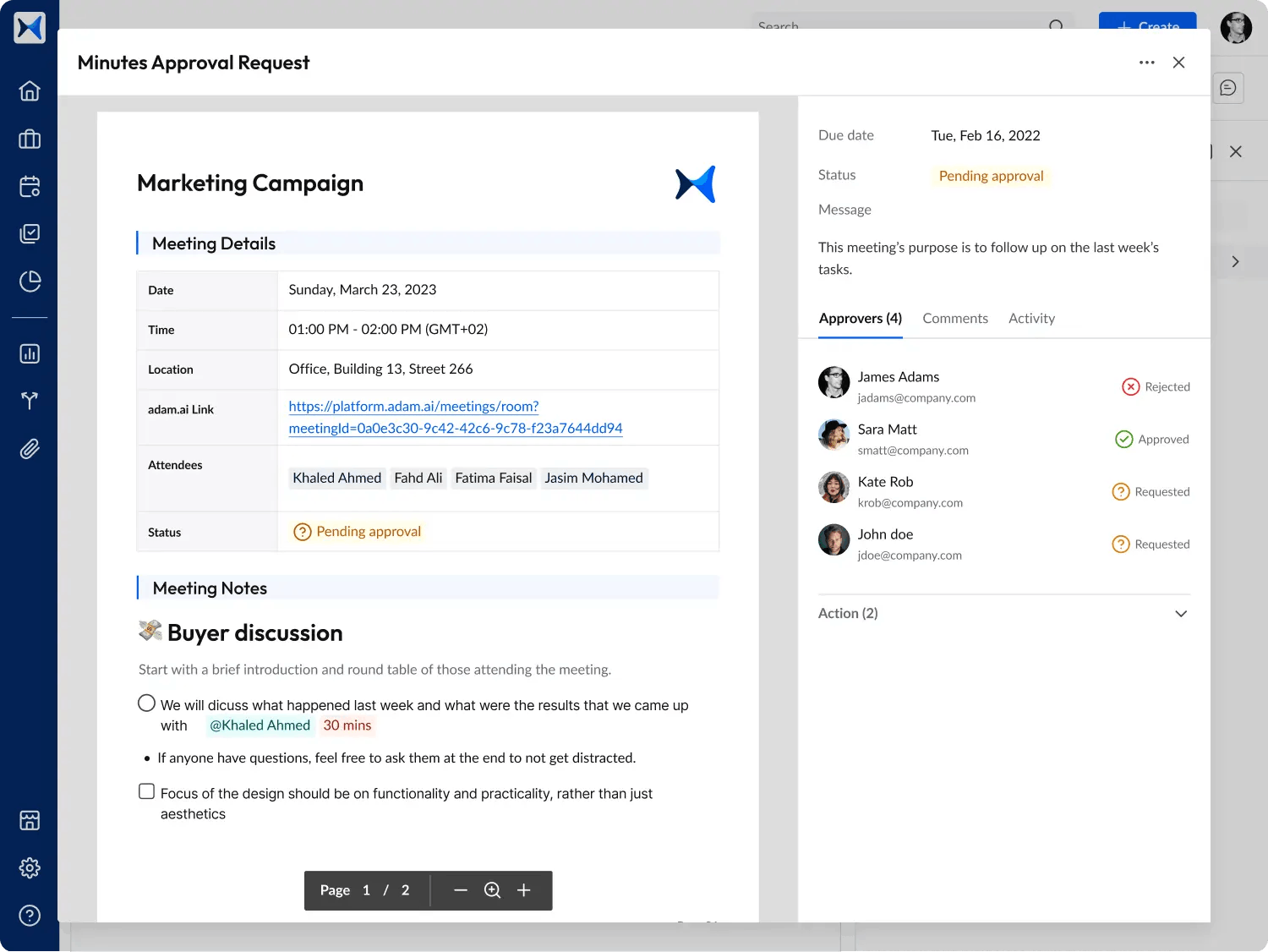
5. Multi-space management
Legal advisory committees often operate across multiple projects or organizational areas. adam.ai’s multi-space management allows committees to organize meetings and documentation by topic, project, or department. This structure ensures that information remains accessible and well-organized, even when dealing with diverse or overlapping responsibilities.
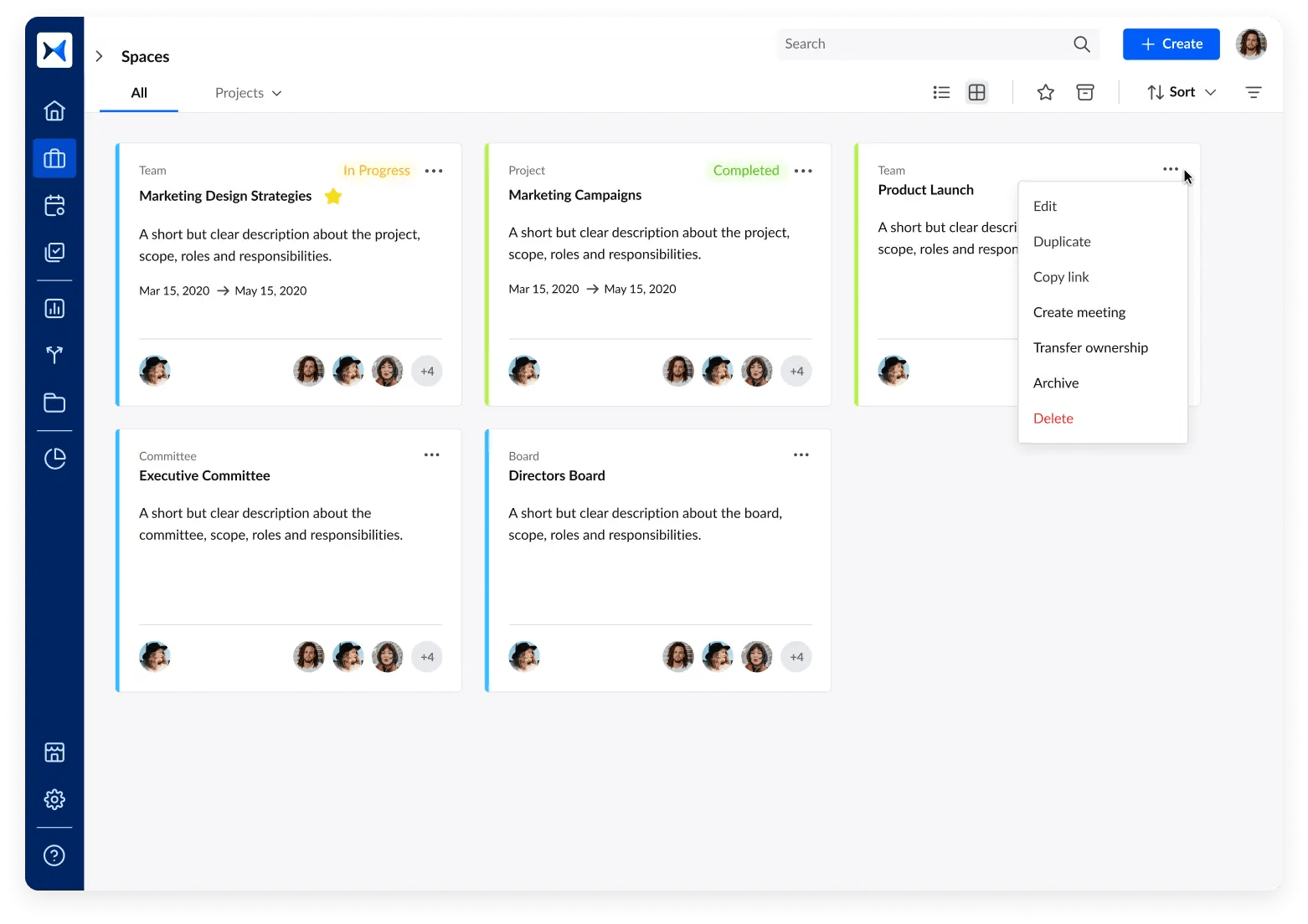
6. Analytical dashboards
To monitor progress and evaluate effectiveness, adam.ai offers analytical dashboards that provide insights into task completion, meeting outcomes, and follow-ups. Legal advisory committees can use these dashboards to identify trends, measure the impact of their decisions, and ensure alignment with organizational goals.
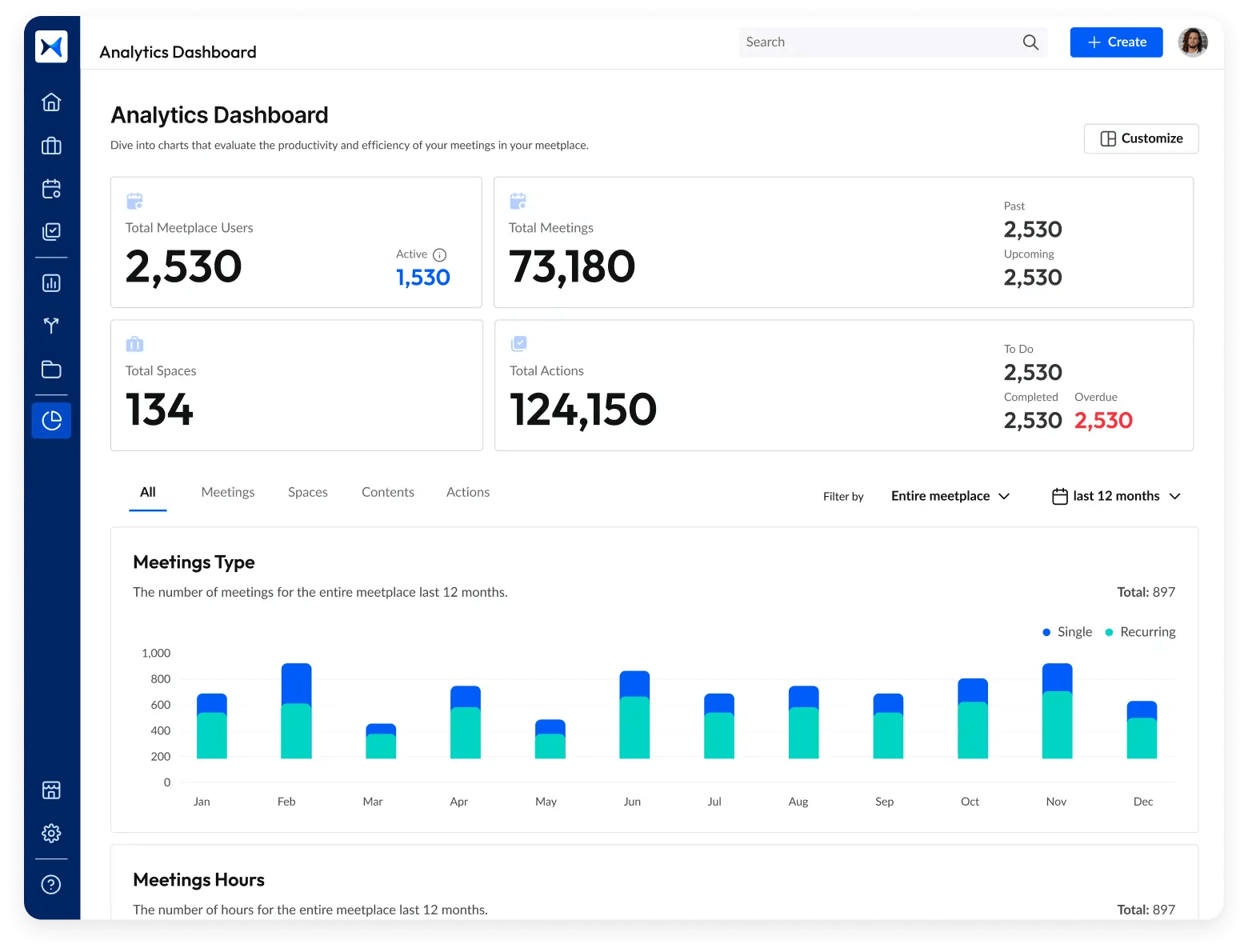
Transform how you conduct critical meetings—From meticulous preparation to effective execution and insightful follow-up, adam.ai integrates comprehensive analytics, full customization, and intuitive interfaces with powerful meeting management tools.
Easy onboarding. Enterprise-grade security. 24/7 dedicated support.
The bottom line
Streamlined documentation and follow-ups are essential for legal advisory committees to maximize their effectiveness and deliver results. Platforms like adam.ai provide tailored solutions to empower these committees, making governance more efficient, transparent, and impactful.
And while there may be multiple solutions available, here is why adam.ai is the meeting management software platform you can trust:
- adam.ai is one of Atlassian Ventures' portfolio companies.
- In the meeting management software category on G2, adam.ai has been ranked a leader and a high performer for successive quarters in the past years.
- adam.ai has been included in the Forrester Report in the AI-enabled meeting technology landscape.
- adam.ai is trusted and used by powerful teams and organizations worldwide for all types of critical meetings, like board, committee, project management, and business development meetings.
- And most importantly, adam.ai integrates with your existing workflow, is SOC2 compliant, provides dedicated support and success, and has a free trial option.
Subscribe to adam.ai blog
Stay ahead with the latest insights—get our newest blog posts, tips, and updates sent straight to your inbox.